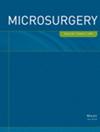Vessel Selection in Head and Neck Reconstruction After Neck Dissection or Radiotherapy
Abstract
Background
Free flap transfer is an essential technique for head and neck reconstruction after oncological ablative resection. Selection of recipient vessels can be challenging in patients with a history of neck dissection and/or radiotherapy. We analyzed outcomes with regard to recipient vessel selection and flap failure, referring to patients' histories of radiotherapy and/or neck dissection.
Methods
Records of 671 patients who had undergone head and neck reconstruction in our institution from April 2018 to March 2024 were retrospectively reviewed. We divided patients into four groups based on their treatment history: radiotherapy alone (RT, n = 82), neck dissection alone (ND, n = 43), both radiotherapy and neck dissection (NDRT, n = 39), and intact neck with no history of radiotherapy or neck dissection (IN, n = 488). We collected data on flap types, defect areas, selected recipient vessels, and the occurrence of flap failure. We also assessed the risk factors for flap failure.
Results
In Group RT, 66 of 84 (79%) recipient vessels were located within irradiated areas. In contrast, in Group ND, 37 of 45 (82%) recipient vessels were outside the dissected areas. No significant association was observed between overall flap failure and variables we assessed. However, our additional flap failure analysis by arterial or venous factors showed an association with the patients' history of radiation treatment (p < 0.05) and in cases where anastomosed vessels were actually located within irradiated areas (p < 0.05).
Conclusion
In patients with previous radiotherapy history, recipient vessels even within irradiated areas can often be successfully used as recipient vessels. However, after undergoing irradiation treatment, the risk of venous-related flap failure may be higher compared with the non-irradiated area; thus, it necessitates careful consideration during reconstruction.

 求助内容:
求助内容: 应助结果提醒方式:
应助结果提醒方式:


